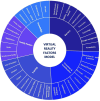Factors influencing virtual reality use in paediatric acquired brain injury upper limb rehabilitation: a qualitative study
- PMID: 39819954
- PMCID: PMC11751983
- DOI: 10.1136/bmjopen-2023-083120
Factors influencing virtual reality use in paediatric acquired brain injury upper limb rehabilitation: a qualitative study
Abstract
Objective: Upper limb movement difficulties in children with acquired brain injury (ABI) result in longer recovery times compared with lower limb. Intensive neurorehabilitation promotes a good long-term functional outcome. Virtual reality (VR) and video game technologies are invaluable adjuncts to traditional neurological rehabilitation as they help to motivate, engage and gain children's compliance in goal-directed therapy. However, this technology is not routinely used in the National Health Service, UK; it requires embedding to benefit children and their families. VR implementation in rehabilitation practice requires development. The associated influencing factors require further exploration before routine use can be established. This project aimed to understand the factors influencing the use of VR in upper limb rehabilitation in children.VR implementation in rehabilitation practice requires development. The associated influencing factors require further exploration before routine use can be established. This project aims to understand the factors influencing the use of VR in upper limb rehabilitation in children.
Design: An interpretative qualitative study used focus groups and 1:1 semi-structured interviews conducted in person and online to explore participants' experiences. These were analysed for inductive overarching themes, particularly focusing on the views of professionals and young people regarding the use of VR in upper limb rehabilitation.
Setting: Two neurorehabilitation services located in two children's hospitals in England, UK.
Participants: Three physiotherapists, five occupational therapists, a play worker and four members from the Young Persons' Advisory Group took part. Four focus groups with 2-4 participants in each group and two 1:1 semi-structured interviews were conducted. Thematic analysis was used to create the model participants described as the factors that influenced the use of VR in neurorehabilitation.
Results: Five closely related major themes and thirty associated subthemes were developed: training, knowledge, promotion, consideration of barriers and family factors. There is a lack of knowledge and understanding about the use of VR, its limitations, and the clinicians' motivation to use it. Training packages with available VR equipment, clinical indicators and scientific evidence are required. Staff need frequent training, logistics (uninterrupted Wi-Fi, software, hardware) and simple instruction manuals.
Conclusion: To introduce VR into the routine rehabilitation of children with ABI, investment in improving knowledge, frequent training and positive behaviour change among health professionals is needed.
Keywords: Developmental neurology & neurodisability; QUALITATIVE RESEARCH; REHABILITATION MEDICINE; Virtual Reality.
© Author(s) (or their employer(s)) 2025. Re-use permitted under CC BY-NC. No commercial re-use. See rights and permissions. Published by BMJ Group.
Conflict of interest statement
Competing interests: None declared.
Figures
Similar articles
-
Virtual reality as a method of cognitive training of processing speed, working memory, and sustained attention in persons with acquired brain injury: a protocol for a randomized controlled trial.Trials. 2024 May 22;25(1):340. doi: 10.1186/s13063-024-08178-7. Trials. 2024. PMID: 38778411 Free PMC article.
-
Medical Device Based on a Virtual Reality-Based Upper Limb Rehabilitation Software: Usability Evaluation Through Cognitive Walkthrough.JMIR Form Res. 2025 Apr 1;9:e68149. doi: 10.2196/68149. JMIR Form Res. 2025. PMID: 40168640 Free PMC article.
-
Virtual reality rehabilitation in children with brain injury: a randomized controlled trial.Dev Med Child Neurol. 2021 Apr;63(4):480-487. doi: 10.1111/dmcn.14762. Epub 2020 Dec 16. Dev Med Child Neurol. 2021. PMID: 33326122 Clinical Trial.
-
Evaluating the impact of virtual reality game training on upper limb motor performance in children and adolescents with developmental coordination disorder: a scoping review using the ICF framework.J Neuroeng Rehabil. 2024 Jun 5;21(1):95. doi: 10.1186/s12984-024-01393-y. J Neuroeng Rehabil. 2024. PMID: 38840217 Free PMC article.
-
Immersive VR for upper-extremity rehabilitation in patients with neurological disorders: a scoping review.J Neuroeng Rehabil. 2024 May 11;21(1):75. doi: 10.1186/s12984-024-01367-0. J Neuroeng Rehabil. 2024. PMID: 38734690 Free PMC article.
References
-
- Abdullahi A, Wong TWL, Ng SSM. Variation in the rate of recovery in motor function between the upper and lower limbs in patients with stroke: some proposed hypotheses and their implications for research and practice. Front Neurol. 2023;14:1225924. doi: 10.3389/fneur.2023.1225924. - DOI - PMC - PubMed
MeSH terms
LinkOut - more resources
Full Text Sources


